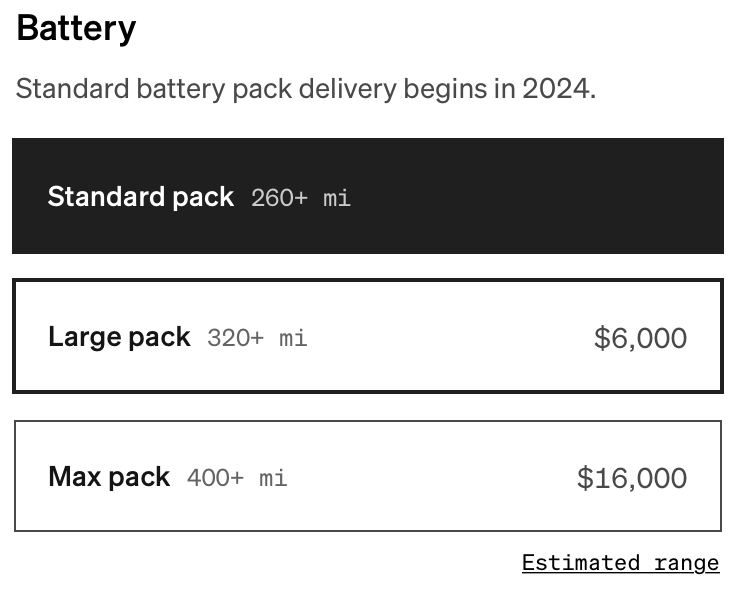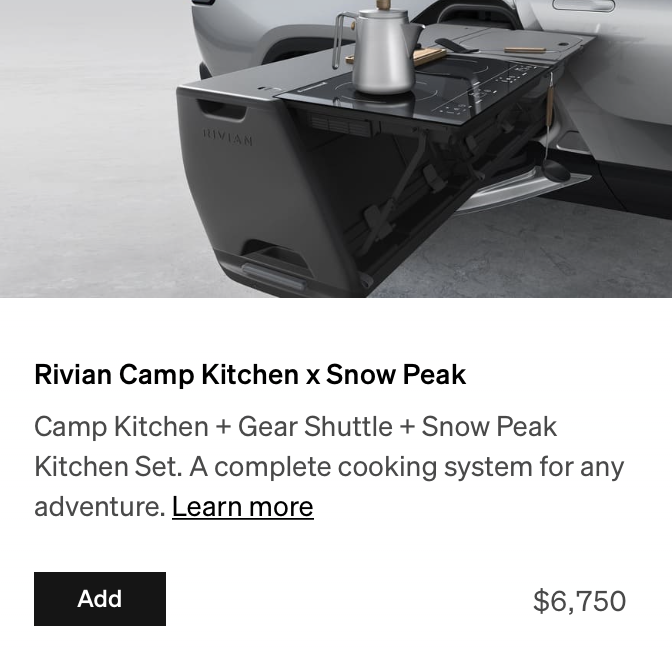Author: Chang Yan
As we enter 2022, news about price increases for Tesla has been on a downward trend. Not because people have become numb to writing about it, but because the entire automotive industry is experiencing price hikes. Even the previously held conclusion by various experts that “cars are rapidly depreciating consumer goods” is being challenged. If you choose the right car, you might even be able to earn some money rather than lose it.

In such an absurd world, while “electric car price hikes” remains a current topic, Rivian has unexpectedly made a new breakthrough. It’s as if Tesla opened the door for Rivian, and it’s truly outrageous.
Welcome to Rivian’s Low-End Dual-Motor Version
Yes, you read that right. Rivian’s low-end version is the dual-motor version. While dual motors are still flagship products at other manufacturers, Rivian has already surpassed that with four motors.

I believe most of you have seen Rivian’s classic tank turning video, which is achieved through four motors providing rotating forces in different directions to each wheel. Up to now, all vehicles produced by Rivian are still four-motor models.
Yesterday in the United States, Rivian announced the launch of a new vehicle configuration, with the changes mainly focusing on two aspects.

The first is the introduction of the dual-motor version. But do not simply understand this as the power being halved from the four-motor version. Although there are fewer motors, their capabilities have been increased. The motors used in the four-motor version were procured from Bosch, while this time Rivian has used their own motors.

Looking at the specifications, the four-motor version provided over 800 horsepower, while the dual-motor version is capable of outputting over 600 horsepower. Rivian’s previously admired multi-axis torque control is still retained, while the entire power style has been adjusted to a rear-wheel-drive style. This preserves the vehicle’s off-road and highway passing capabilities, and does not affect the crucial towing ability for American pickups.
 ## Second is the introduction of the standard battery. Just like the classic medium, large, and extra-large cups of old Lu, Rivian’s battery packs have also become classic, large, and extra-large.
## Second is the introduction of the standard battery. Just like the classic medium, large, and extra-large cups of old Lu, Rivian’s battery packs have also become classic, large, and extra-large.
As before, the official website does not provide specific battery capacity, but we can see the estimated EPA range.

The previous large battery can provide an EPA range of 512 km, and the extra-large battery can provide a range of 640 km.
The current standard battery corresponds to a range of 416 km.

In addition, the R1S SUV, which is still in the reservation stage, has canceled all 5-seat options, and only 7-seat configurations are available upon delivery.
This way of price increase is unprecedented
At first glance, isn’t it great? These are all configurations that everyone loves, and:
It should be much cheaper, right?

But when everyone selected the lowest configuration in Rivian’s configuration interface, the system popped up the familiar prices of $67,500 for R1T and $70,000 for R1S.
Why is it familiar?
Because the previous four-motor + large battery was also priced at this level.
Yes, Rivian has adopted the magical method of reducing configuration but not price, resulting in an actual price increase of 17-20% for the entire series.
Converted into money, it is $12,000-$14,000, not including optional equipment.

In fact, optional configurations are also becoming more expensive. For example, the kitchen kit, which became popular among Rivian fans before, has also increased from $5,500 to $6,750.
Previously, there was an unwritten rule for price increases, called “one who suffers should not be old car owners”.
Basically, car owners who have paid the deposit can sit back and relax.

But this time they got caught up in it themselves.
Rivian announced that as long as your car has not been delivered, you must follow the new price standards.

A user who saved a screenshot of an order stated that the car that originally cost $85,100 suddenly became $101,650.
Many users who have waited for almost a year with Rivian are also irritated that not only have they not received their cars, but they are also facing price increases?
Of course, Rivian also stated that you can choose not to accept the price increase, and then the current order will be automatically converted to a dual-motor + standard battery.

In other words, for the same price, you will get two fewer motors, 100 km less range, and acceleration from 3 seconds to 4 seconds.
But that’s not all, you won’t be able to get this configuration until 2024.
Why?
Because Rivian will only start producing dual-motor models in 2024…
Will all of this mark the beginning of an industry phenomenon?
Of course, Rivian has its reasons.
What price am I using? I’m using the price from four years ago. How do you expect me to sell it? I can’t sell it.
Rivian’s explanation is that the existing reservation price was set in 2018, and in the four years since then, the overall cost of key components has increased by 37%.

Rivian’s Chief Growth Officer, Jiten Behl, wrote in a letter to users: “Like most manufacturers, Rivian is facing inflationary pressures, rising component costs and unprecedented supply chain shortages and delays affecting parts (including semiconductor chips).”
“As these challenging conditions lead to increased costs and complexity, we need to raise the price of the R1T and R1S models we offer today.”
And this phenomenon involves not only Rivian. As early as the Hainan Auto Show in January of this year, the CEO of a car company told me that if it was a simple shortage of a single component, the car companies could bear the costs, but if it was a price increase of such a large scale and high net value for power batteries, the car companies had to seek to transfer the costs through price increases.
Rivian’s recent price increase has caused a significant backlash from consumers and is also worth paying attention to for changes in follow-up orders. However, this may become a collective action by car companies in the near future.
Starting from this point, in addition to single-car intelligence and material handling, how to reduce costs and increase efficiency through improving production capacity, as well as how to have a deeper grasp of the upstream and downstream industries, seem to be the next BOSS that electric vehicle companies want to face in order to expand their businesses.

While writing this article, Musk added fuel to the fire by commenting on Rivian’s price increase, saying, “Their negative gross margin is definitely very high this year.”
However, don’t get too excited yet. Trust me, if the entire industry raises prices, shrewd Mr. Musk will not give up the lucrative returns brought by price increases.
This article is a translation by ChatGPT of a Chinese report from 42HOW. If you have any questions about it, please email bd@42how.com.
